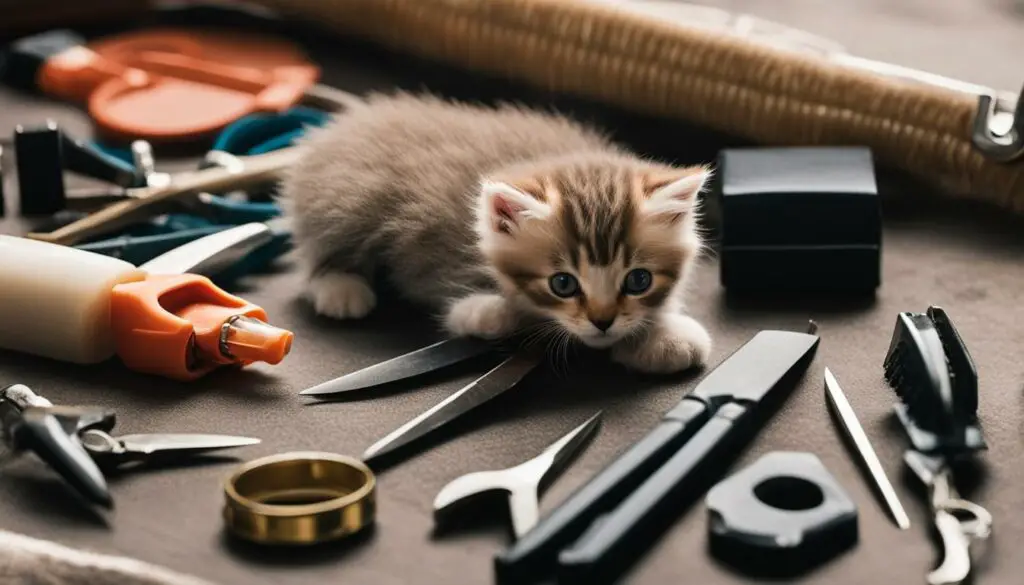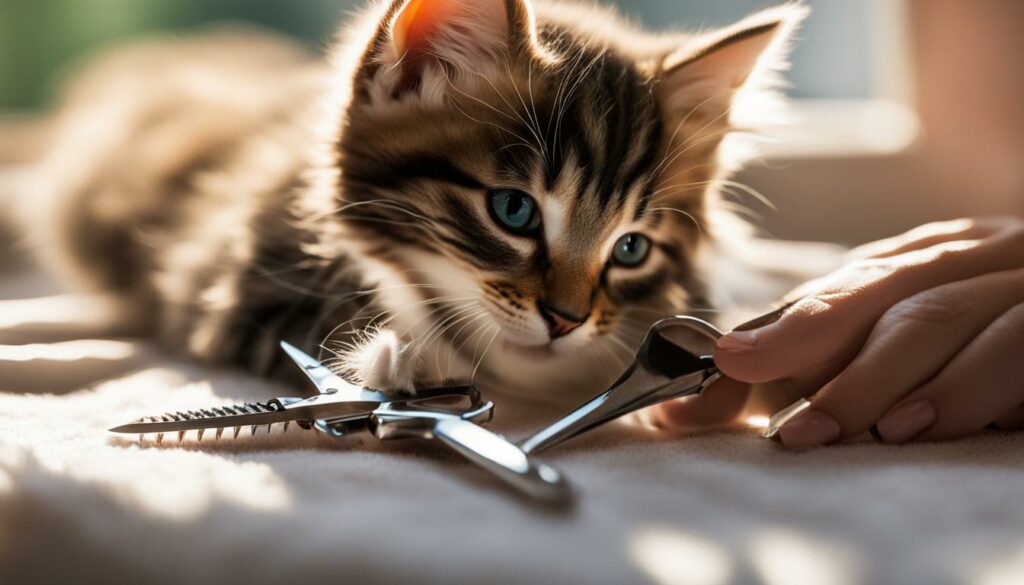Grooming your kitten is an important part of their overall care, and that includes trimming their nails. But when is the right time to start? In this guide, I will share with you essential information on when to start trimming your kitten’s nails and how to make the process as stress-free as possible.
Key Takeaways:
- Start introducing nail trimming to your kitten’s routine from a young age to help them get used to it
- Even older cats can be trained to tolerate and enjoy nail trims
- Choose a calm, quiet location and trim their nails when they are sleepy for a more positive experience
How to Start Training Your Kitten for Nail Trimming
To ensure that your kitten becomes comfortable with nail trimming, it’s important to start training them from a young age. By implementing positive reinforcement techniques and following a few simple steps, you can make the nail trimming experience a positive one for both you and your furry friend.
Begin by holding your kitten’s paws and gently rubbing them while talking to them in a soothing voice. This helps them become familiar with the sensation of having their paws handled. Slowly squeeze their fingers and toes so that their nails extend, and then release them immediately. This will help them understand that the process is not harmful or painful. Remember to be patient and consistent in your training efforts.
How to Start Training Your Kitten for Nail Trimming
Offering treats as a form of positive reinforcement is an effective way to encourage your kitten during the training process. Reward them with a small treat after each successful nail trimming session or even just for allowing you to handle their paws. This helps create a positive association with the nail trimming experience and encourages cooperation.
Remember to remain calm and patient throughout the training process. Some kittens may take longer to adjust to nail trimming than others, so it’s essential to be understanding and give them the time they need. With consistent training and positive reinforcement, your kitten will soon become comfortable with nail trims and even enjoy the process.

Table:
| Training Steps | Tips |
|---|---|
| Start young | Introduce nail trimming to your kitten’s routine from a young age to help them get used to it. |
| Handle their paws | Gently hold and rub your kitten’s paws to familiarize them with the sensation. |
| Squeeze and release | Squeeze their fingers and toes to extend their nails, then release them immediately to show that it’s not painful. |
| Offer treats | Use treats as a form of positive reinforcement to reward your kitten for cooperative behavior. |
| Be patient | Some kittens may take longer to adjust to nail trimming, so it’s important to remain patient throughout the training process. |
Choosing the Right Tools for Kitten Nail Trimming
When it comes to grooming your kitten’s nails, selecting the right tools is essential. Investing in high-quality nail clippers designed specifically for cats will ensure a safe and effective trimming process. These clippers have sharp, angled blades that make it easier to trim your kitten’s nails with precision.
Additionally, it’s important to consider the size of the clippers. Opt for clippers that are suitable for small paws, as using larger clippers may cause discomfort or injury to your kitten. The size of the clippers should allow you to hold them comfortably and have a firm grip for better control during the trimming process.
Another tool you may find helpful is a nail file or emery board. This can be used to smooth out any rough edges after trimming your kitten’s nails, preventing any accidental scratching or snagging. However, be cautious when using a nail file, as over-filing can weaken and damage your kitten’s nails.
Remember to always offer a reward or treat after each successful nail trimming session. This positive reinforcement will help your kitten associate the experience with something enjoyable, making future nail trims easier and more cooperative.

Tips for Choosing the Right Nail Clippers:
- Look for nail clippers specifically designed for cats.
- Choose clippers that are the right size for your kitten’s paws.
- Ensure the clippers have sharp, angled blades for precise trimming.
- Consider using a nail file or emery board to smooth out rough edges after trimming.
Benefits of Using High-Quality Nail Clippers:
“Using high-quality nail clippers designed for cats ensures a safe and effective nail trimming process. They provide better control and precision, reducing the risk of injury or discomfort for your kitten. Invest in the right tools to make nail trimming a positive and stress-free experience for both you and your furry friend.” – Pet Grooming Expert
| Benefits of Choosing the Right Tools | Consequences of Using Incorrect Tools |
|---|---|
| Safe and efficient nail trimming | Risk of injury or discomfort for your kitten |
| Precise trimming for better nail health | Inaccurate cuts leading to nail breakage or damage |
| Reduced stress and anxiety during nail trims | Increased resistance and fear during the trimming process |
By choosing the right tools for kitten nail trimming, you can ensure a safe and positive experience for both you and your furry friend. Remember to always handle your kitten’s paws with care and trim their nails with precision, avoiding the quick to prevent any pain or discomfort. With the right tools and gentle handling, nail trimming can become an enjoyable part of your kitten’s grooming routine.
How Often to Trim Kitten Nails
When it comes to maintaining your kitten’s nail health, regular trimming is essential. But how often should you trim their nails? The frequency of kitten nail trimming depends on their activity level and scratching habits. As a general guideline, cats usually require nail cutting every 2-3 weeks. However, it’s important to monitor their nails and trim them when they appear long, curved, and razor-sharp. It’s better to trim their nails more often than to let them become too long.
Trimming your kitten’s nails not only helps prevent discomfort, but it also reduces the risk of accidental injury and damage to furniture and other surfaces. By keeping their nails at an appropriate length, you can ensure their comfort and well-being.
To determine the best time to trim your kitten’s nails, observe their behavior. If you notice them scratching more frequently, their nails may need trimming. Additionally, examine their nails visually. If you see the tips curling or notice any sharp points, it’s a good indication that a trim is needed.
| Kitten’s Activity Level | Recommended Trimming Frequency |
|---|---|
| Highly active, outdoor kittens | Every 2-3 weeks |
| Indoor-only, moderately active kittens | Every 3-4 weeks |
| Sedentary, low-activity kittens | Every 4-6 weeks |
Remember, every kitten is unique, and their nail growth rate may vary. It’s important to monitor their nails regularly and adjust the trimming frequency accordingly.
Providing Alternatives to Scratching
Kitten nail health is essential for their overall well-being. Along with regular nail trimming, providing alternatives to scratching is crucial to keep their nails naturally worn down and prevent destructive scratching behavior. Investing in a scratching post or pad can fulfill their instinctive urge to claw while protecting your furniture and other surfaces. Place the scratching post in an accessible and prominent location, such as near their favorite sleeping spot or in a high-traffic area.

When choosing a scratching post, opt for one that is sturdy and tall enough for your kitten to fully stretch and scratch. Look for materials like sisal rope or cardboard, which provide an enticing texture for kittens. To encourage your kitten to use the scratching post, apply catnip or a pheromone spray to make it more enticing. Praise and reward your kitten when they use the scratching post, reinforcing positive behavior.
It’s also important to redirect your kitten’s attention if you catch them scratching furniture or other inappropriate surfaces. Distract them with a toy or make a loud noise to startle them, then guide them towards the scratching post. Remember to be patient and consistent in your training efforts, as it may take some time for your kitten to fully adopt the habit of using the scratching post.
Table: Comparison of Scratching Alternatives
| Scratching Alternative | Pros | Cons |
|---|---|---|
| Scratching Post |
|
|
| Scratching Pad |
|
|
| Cardboard Scratcher |
|
|
Grooming Kitten Nails: Seeking Professional Assistance
Grooming a kitten’s nails can be a challenging task, especially for first-time cat owners. If you are unsure about how to trim your kitten’s nails or feel nervous about the process, seeking professional assistance is always a good idea. Veterinarians and groomers are trained in handling and grooming cats, and they can provide guidance, tips, and even demonstrate the proper technique for nail trimming.
When you consult with a professional, they will be able to assess and evaluate your kitten’s specific needs. They can recommend the most suitable tools, such as nail clippers or alternatives like nail grinders, based on your kitten’s size, temperament, and nail condition. Additionally, they can educate you about the importance of regular nail trimming and offer advice on establishing a grooming routine that works for both you and your kitten.
“Consult with a veterinarian or a groomer who can provide guidance, tips, and even demonstrate the proper technique.”
Professional assistance can also help ensure that you and your kitten have a positive experience during nail trimming sessions. They can provide a calm and controlled environment, minimizing stress and anxiety for both of you. Additionally, they can offer advice on how to soothe and comfort your kitten during the grooming process, using techniques such as gentle handling, positive reinforcement, and distraction.
Remember, seeking professional assistance for grooming your kitten’s nails is not a sign of failure or incompetence. It is a proactive step towards maintaining their overall health and well-being. By working with experts, you can gain the knowledge and confidence necessary to provide the best care for your furry friend.
Summary:
- Seeking professional assistance for grooming your kitten’s nails is a wise decision, especially if you are unsure or nervous about the process.
- Veterinarians and groomers can provide guidance, tips, and demonstrate the proper technique for nail trimming.
- Consulting with professionals can help you assess your kitten’s specific needs, recommend suitable tools, and establish a grooming routine.
- Professional assistance ensures a calm and controlled environment, minimizing stress for both you and your kitten.
- Working with experts allows you to gain knowledge and confidence in providing the best care for your kitten’s nail health.

Making Nail Trimming a Positive Experience
Nail trimming can be a challenging task when it comes to kittens. However, by making the experience positive, we can ensure their cooperation and comfort during the process. Here are some tips to make nail trimming a positive experience for your kitten:
Create a Calm and Quiet Environment
Choose a calm and quiet location for nail trimming sessions. This will help reduce any potential stress or anxiety your kitten might feel. Find a comfortable spot where they feel secure, such as a quiet room or a cozy corner of your home.
Offer Treats as Rewards
Positive reinforcement is key when it comes to training your kitten for nail trimming. Offer treats as rewards before, during, and after the nail trimming session. This will help create a positive association with the process and make it more enjoyable for your kitten.
“I always keep a bag of my kitten’s favorite treats nearby during nail trimming sessions. It helps them stay calm and focused, and they even look forward to it now!” – Cat lover and nail trimming enthusiast
Provide Gentle and Reassuring Handling
Handle your kitten’s paws gently and reassuringly during nail trimming. Talk to them in a soothing voice and provide gentle massages to help them relax. By creating a sense of trust and security, your kitten will feel more comfortable and cooperative during the nail trimming process.
Remember, making nail trimming a positive experience is essential for your kitten’s overall well-being. By creating a calm environment, offering treats as rewards, and providing gentle handling, you can help ensure a stress-free nail trimming session. With patience and consistency, your kitten will become comfortable with the process, making it easier for both of you in the long run.

| Benefits of Positive Nail Trimming Experience | Tips for a Positive Experience |
|---|---|
| Promotes healthy nail growth | Create a calm and quiet environment |
| Reduces scratching-related issues | Offer treats as rewards |
| Prevents accidental injury or damage | Provide gentle and reassuring handling |
| Promotes bonding between you and your kitten | Make nail trimming a regular routine |
Kitten Nail Trimming Tips: Mastering the Proper Technique
When it comes to grooming your kitten’s nails, mastering the proper technique is essential for their comfort and safety. By following these helpful tips, you can ensure a successful and stress-free nail trimming session.
Choose the Right Time and Place
Find a calm and quiet location for nail trimming to help create a positive experience for your kitten. Choose a time when they are relaxed, such as after a nap or a play session. By trimming their nails when they are less likely to be restless, you can work more effectively and minimize the risk of accidents.
Hold Your Kitten Securely
When trimming your kitten’s nails, hold them securely but gently. Place one hand around their body to provide support and use your thumb and index finger to hold their paw. By keeping a firm yet gentle grip, you can ensure stability and reduce the chances of accidental cuts or scratches.
Trim Only the Tips
When using nail clippers, be cautious and only trim the sharp tips of your kitten’s nails. Avoid cutting too close to the quick, which is the sensitive area that contains blood vessels and nerves. If you’re uncertain about how much to trim, it’s better to err on the side of caution and gradually trim small portions.
Be Prepared for Accidents
Accidents can happen, especially if your kitten is particularly squirmy or anxious during nail trimming. Have styptic powder or a dry bar of soap on hand to stop any bleeding if you accidentally cut into the quick. Apply gentle pressure to the affected area and reassure your kitten with soothing words and comforting gestures.
The Importance of Regular Nail Trimming
Regular nail trimming is an essential aspect of kitten nail care and plays a significant role in maintaining their overall health. Overgrown and sharp nails can cause discomfort to your kitten and pose potential risks to both them and your home. By keeping their nails at an appropriate length, you can prevent scratching-related issues, such as accidental injury or damage to furniture and other surfaces.
Nail trimming should be a routine part of your kitten’s grooming regimen. Not only does it promote their well-being, but it also helps prevent potential problems that may arise from neglected nails. If left untrimmed, nails can become excessively long, curved, and razor-sharp, making it difficult for your kitten to walk and causing discomfort when scratching.
To ensure your kitten’s comfort and safety, it is recommended to trim their nails every 2-3 weeks or as needed. By establishing a regular nail trimming schedule, you can keep their nails in optimal condition and mitigate potential issues. If you are unsure about how to trim your kitten’s nails or find it challenging to do so on your own, don’t hesitate to seek professional assistance from a veterinarian or a groomer who can provide guidance and demonstrate the proper technique.
| Benefits of Regular Nail Trimming |
|---|
| 1. Prevents accidental scratches and injuries |
| 2. Protects your furniture and surfaces from damage |
| 3. Reduces the risk of ingrown nails |
| 4. Promotes your kitten’s overall comfort and well-being |
“Regular nail trimming is an essential part of kitten nail care, as it not only prevents potential injuries but also contributes to their overall comfort and well-being.” – Dr. Sarah Johnson, Veterinarian
The Risks of Declawing Cats
Declawing cats is a controversial and highly discouraged practice that involves the surgical amputation of a cat’s claws. While it may seem like a convenient solution to prevent scratching-related issues, declawing poses serious risks to a cat’s health and well-being. It is important for cat owners to understand the implications of this procedure and seek alternative solutions for managing their cat’s scratching behavior.
The primary concern with declawing is the significant pain and discomfort it causes to cats. The procedure involves the removal of not just the claws but also the last bone of each toe. This can result in long-term pain and complications, including chronic pain, nerve damage, and difficulty walking. Cats may also experience behavioral issues such as increased aggression, litter box problems, and decreased overall quality of life.
Instead of declawing, there are more humane alternatives to manage a cat’s scratching behavior. Providing appropriate scratching alternatives, such as scratching posts or pads, can fulfill their natural instinct to scratch. Regular nail trimming is also essential for maintaining nail health and preventing scratches. Additionally, cat owners can consider using nail caps, which are soft covers that are glued onto the cat’s nails to prevent scratching damage.
| Risks of Declawing Cats | Alternatives to Declawing |
|---|---|
| Significant pain and discomfort | Provide scratching alternatives |
| Long-term complications | Regular nail trimming |
| Behavioral issues | Use nail caps |
It is important to prioritize the well-being and welfare of our feline companions. Instead of resorting to declawing, let’s focus on understanding their natural behaviors and finding compassionate solutions that allow them to express their instincts without causing harm. By providing appropriate alternatives and practicing regular nail care, we can promote a happy and healthy environment for both cats and their human companions.
Tips for a Stress-Free Nail Trimming Session
Trimming your kitten’s nails can sometimes be a challenging task, but with the right approach, it can become a stress-free experience for both you and your furry friend. Here are some tips to help make nail trimming a positive and rewarding activity:
- Choose the right time: Find a time when your kitten is calm and relaxed, such as after playtime or when they are sleepy. This will make them more receptive to the nail trimming process.
- Introduce the tools gradually: Start by simply showing your kitten the nail clippers and letting them sniff and investigate them. This helps them become familiar with the tools and reduces any fear or anxiety.
- Use positive reinforcement: Reward your kitten with treats, praise, or a favorite toy before, during, and after the nail trimming session. This creates a positive association and makes them more willing to cooperate.
- Take it slow: Start by trimming just a few nails at a time. If your kitten becomes restless or anxious, don’t force the issue. End the session and try again later.
- Be gentle and cautious: When trimming the nails, be careful not to cut into the quick, which can cause bleeding and pain. Take small, gradual cuts and check each nail before proceeding.
“Patience and a relaxed environment are key when it comes to nail trimming. By approaching the process with calmness and positivity, you can help your kitten feel more at ease and ensure a stress-free experience.”
Remember, it’s normal for kittens to be a bit resistant to nail trimming at first. It may take time for them to become completely comfortable with the process. Start early, be patient, and always reward your furry friend for their cooperation.
| Tip | Benefits |
|---|---|
| Choose the right time | Reduces stress and resistance |
| Introduce the tools gradually | Builds familiarity and reduces fear |
| Use positive reinforcement | Creates a positive association |
| Take it slow | Prevents restlessness and anxiety |
| Be gentle and cautious | Avoids pain or injury |

Tips for a Successful Nail Trimming Session
When attempting to trim your kitten’s nails, it’s important to approach the process with patience and a calm demeanor. By following these tips, you can create a stress-free environment and ensure a successful nail trimming session:
- Prepare the environment: Choose a quiet and well-lit area where you and your kitten can both feel comfortable. Remove any distractions or potential hazards.
- Have treats or rewards ready: Keep a supply of your kitten’s favorite treats nearby to offer as positive reinforcement during and after the nail trimming session.
- Take breaks if needed: If your kitten becomes anxious or restless, take a break and give them some time to relax before continuing. This can help prevent any negative associations with the nail trimming process.
- Involve another person if necessary: If your kitten is particularly resistant or anxious, having another person hold and comfort them during the nail trimming session can make the process easier.
Remember, every kitten is different, and it may take some time for them to adjust to nail trimming. By creating a positive and calm environment, using rewards, and taking it slow, you can help your kitten become more comfortable with the process over time.
Maintaining Nail Trimming Routine
Once you have established a regular nail trimming routine for your kitten, it’s important to maintain it to ensure their nails stay in optimal condition. By consistently trimming their nails every 2-3 weeks or as needed, you can prevent overgrowth, discomfort, and potential scratching-related issues.
To help you stay on track with your kitten’s nail care, consider setting reminders or marking the dates on your calendar. Consistency is key in establishing a routine and keeping your kitten’s nails at an appropriate length.
However, if you find it challenging to trim your kitten’s nails on your own or if your kitten becomes extremely resistant, it may be beneficial to seek assistance from a professional groomer or veterinarian. They have the experience and expertise to handle the process effectively and safely, ensuring a positive experience for both you and your kitten.
Remember, regular nail trimming is an essential part of your kitten’s overall grooming routine. By staying consistent and seeking professional help when needed, you can keep your kitten’s nails healthy and prevent any discomfort or potential problems they may encounter.

Table: Frequency of Kitten Nail Trimming
| Activity Level | Frequency of Nail Trimming |
|---|---|
| Low | Every 3-4 weeks |
| Moderate | Every 2-3 weeks |
| High | Every 1-2 weeks |
In addition to regular nail trimming, it’s also important to provide your kitten with appropriate scratching alternatives. This can include investing in a scratching post or pad and encouraging them to use it regularly. By redirecting their scratching behavior to a suitable surface, you can help keep their nails naturally worn down and reduce the need for frequent trims.
By maintaining a consistent nail trimming routine and offering scratching alternatives, you can ensure the overall health and well-being of your kitten while also preventing any potential damage to furniture or surfaces.
Conclusion
In conclusion, trimming your kitten’s nails is an essential part of their grooming routine. By starting early and using positive reinforcement techniques, you can train your kitten to tolerate and even enjoy nail trims. Remember to choose the right tools and location, be gentle and cautious during the trimming process, and provide alternatives to scratching.
Regular nail trimming is crucial for your kitten’s overall health and well-being. It helps prevent discomfort, accidental injuries, and damage to furniture. Maintaining a regular nail trimming routine every 2-3 weeks or as needed will ensure your kitten’s nails are kept at an appropriate length.
While it’s important to trim your kitten’s nails, it’s equally important to approach the process with patience and a calm demeanor. Create a positive atmosphere by offering treats, toys, and gentle handling. If you find it challenging to trim their nails on your own, don’t hesitate to seek assistance from a professional groomer or veterinarian.
Remember, the best time to trim your kitten’s nails is when they are relaxed and sleepy. By following these tips and guidelines, you can make nail trimming a stress-free and enjoyable experience for both you and your furry friend.
FAQ
When should I start trimming my kitten’s nails?
It is best to start trimming your kitten’s nails from a young age to help them get used to it.
How do I train my kitten for nail trimming?
Begin by holding their paws and rubbing them gently while talking to them. Offer treats as positive reinforcement.
What tools should I use for trimming my kitten’s nails?
Invest in quality nail clippers designed for cats. It is important to choose the right tools for safe and effective trimming.
How often should I trim my kitten’s nails?
Cats usually require nail cutting every 2-3 weeks, but monitor their nails and trim them as needed.
Do I need to provide alternatives to scratching?
Yes, it is important to provide your kitten with alternatives to scratching, such as scratching posts or pads.
Should I seek professional assistance for nail trimming?
If you are unsure or nervous about trimming your kitten’s nails, it is always a good idea to seek professional guidance.
How can I make nail trimming a positive experience for my kitten?
Create a calm environment, offer treats as rewards, and provide gentle and reassuring handling.
What is the proper technique for kitten nail trimming?
Hold your kitten’s paw gently, press on the pad to expose the claw, and only trim the sharp point, avoiding the quick.
Why is regular nail trimming important for kittens?
Regular nail trimming helps prevent discomfort, injuries, and damage caused by overgrown and sharp nails.
Is declawing cats recommended?
No, declawing is highly discouraged as it involves surgical amputation and can lead to complications and behavioral issues.
How can I have a stress-free nail trimming session with my kitten?
Approach the session with patience and a calm demeanor, provide breaks, rewards, and create a positive atmosphere.
How can I maintain a nail trimming routine for my kitten?
Set a schedule and stick to it, trimming their nails every 2-3 weeks or as needed for their comfort and health.
What is the importance of knowing when to start trimming my kitten’s nails?
Knowing when to start trimming your kitten’s nails ensures they get used to the process early on, making it easier for you and them.








